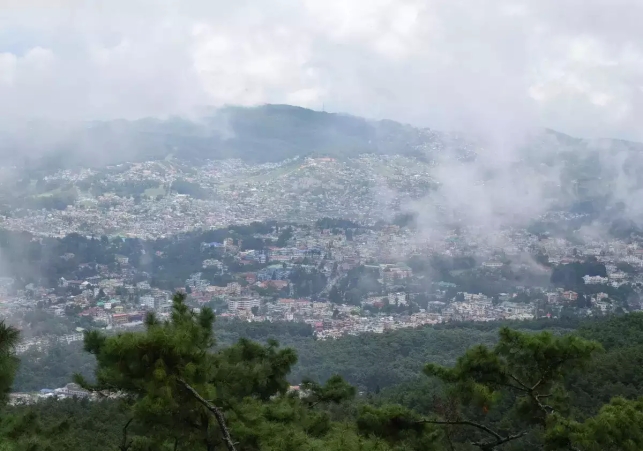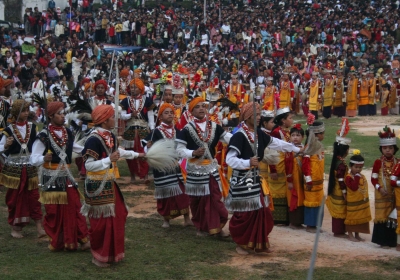Khasi Heritage: The Creation of Nature- Shyllong

The tableland at the highest elevation of Khasi land is a village known as Bisei. It is one of the progressive villages with a large number of inhabitants in the community comprising of various clans. Every clan takes care of their own community land belonging to their respective clan with hardly any conflict with the other clans, because there is a democratic system of demarcation of boundaries between every adjacent land. Apart from natural boundaries of topographical confluences, rivers and forests, there is a system of dividing the adjoining land with a wide stretch of land known as ‘Samraij’ that does not belong to either clan. The demarcation was done through certain ceremonial procedures that sought the concurrence of the spiritual guardian deities of each clan. The ceremony was performed by the maternal uncles of both the clans seeking endorsement of the deities to authenticate and confirm the wide patch of land divided between the land of both the clans. The same procedure will be followed with all the other sides if the land is adjacent to another clan and that particular patch of land does not belong to anybody. Every segment of the community land is inhabited by the descendants of the same clan, where the female members always remain within their community and the male members may travel elsewhere through the wide boundary patch for various purposes. In this way, interaction between communities occurs only during the daytime, because after dusk everybody has to return to the community land of their maternal clan. Usually, only male adolescents and elderly people would venture to the community land of the other clans after due intimation and permission. The female members will hardly venture outside the community land of their maternal clan, except in emergency and rare circumstances.
In one of the community, there is an alleged mentally deranged damsel of Bisei village who used to wander randomly at will without fear of anybody. The family members took care of her, though they never disturbed her actions and gradually ignored her whereabouts as long as she returned home safe. One day, they discovered that the young damsel, Lir was pregnant and when they asked her, she replied that she was not aware of anything. After further interrogation, she confessed that she had never had any contact with any person whatsoever, but could not say anything because she was not in sound mind. It was a shameful situation for the family and the clan that the clan council was compelled to abandon her, particularly when the neighbouring community humiliated her disgraceful behaviour, even as she pledged innocent. Ultimately, she was forced to live on her own and fled away to an isolated place nearby a hillock, which is the highest summit in the area, known as Mylliem Rngi. She constructed a makeshift hut and lived alone, without any worry, until the natal period was ripe. The poor Lir was ignorant of any method to deliver her infant and unfortunately gave birth to a dead child. However, her maternal conscience prompted her to bury the child in the backyard of the hut, as she was not aware of any process to dispose of the deceased. Thereafter, she carried on with her lonely life and was happy with whatever nature provided and the Sylvan deity protected her thoroughly.
The joyful experience of Lir was fantasised in her fairyland and she was living a cheerful life and everything is available within the periphery. She plant pumpkins, gourds, millets and maizes, then she would pluck berries and wild fruits and sometimes she extracted edible roots and bulbs from the earth. This was going on for many years and one fine morning, she heard the sound of implements ploughing the field and hurriedly came out of the hut. The moment she was out of the door, Lir saw many men with shovels and hoes ploughing the field, while an imposing young man was supervising their work. She was scared and pleaded with the young man to leave her field and requested him not to snatch her land that she had cultivated for years. The young man turned towards her and smiled as he addressed her as his mother, even as she had never imagined anything of that sort. He reminded her of his birth, burial and grief that nobody was there to console and sympathise. Lir could not accept his statement and it was not a conventional conception like every human being, because in her life in the village she had witnessed few births by her clan members. She was dumbfounded and stared at the young man as he declared that his name was Shulong, which means self-created by nature. The moment he pronounced the name, a rainbow appeared in the sky embracing them in the bosom of the creator, and the surrounding environment was bright with vibrant colours of nature. The poor lady realised that some divine forces had utilised her as a medium to conceive such a handsome young man who was born death.
The young man asked his mother to fetch all his uncles and aunts from the village, because he wanted to teach them the custom of paying obeisance to the Sylvan deity who resides in the hillock. When they arrived, Shulong instructed them on all the necessary rituals and ceremonies to be performed regularly every year. He assigned the older uncles to take charge of the ceremony and entrusted them to share the responsibility with other clans in the surrounding villages and instructed them to formulate an executive council for administration purposes. Among all the customary practices of the ceremony, Shulong apprised them that at the conclusion of the ceremony all the people should move backwards till they are out of the sacred site, because they can not turn their back towards the sanctum sanctorum. Subsequently, the constitution of the Hima Sawkher Lailyngdoh province took place and every clan of the surrounding villages got their share of responsibilities and obligations to the deities. The Apex hillock was later named after the young man, Shulong, which over the years became Shyllong, where the present capital city, Shillong, derives its name from.







